
Tuar prices surge on account of heavy rains
Mumbai. Rainfall in Karnataka and Andhra Pradesh damaged the ready-to-harvest crop of tuar. Harvesting was delayed due to unseasonal rain. Due to the delay in harvesting and losses, buying in tuar improved and prices registered a surge. Due to better demand from stockists and mills, Mumbai tuar registered an increase of Rs 150 per quintal during the past week and with this increase, lemon rose to Rs. 6,000, Gajri to Rs. 5,200, Arusha to Rs. 5,250 and Sudan to Rs. 6,100 per quintal
Burma
Due to weak export demand, Burma prices fell by $ 10 a tonne. Lemon was traded on $760 and linke at $760/ton.
Delhi
Due to the port's support and improvement in demand, Delhi tuar lemon registered an increase of Rs. 100 per quintal, Maharashtra of Rs. 75 and both Haryana and Uttar Pradesh of Rs. 150 per quintal. Delhi lemon prices rose to Rs. 6,100, Maharashtra to Rs. 6,325, Haryana / Uttar Pradesh to Rs. 5,750 and Madhya Pradesh Rs. 5,950 per quintal.
Maharashtra
Last week, buying by mills and stockists was better in Maharashtra, resulting in a jump in prices. A jump of Rs 350 per quintal was registered in Latur, Rs. 150 in Akola, Rs. 200 in Nagpur and Rs. 200 in Barshi and, as a result, Latur reached Rs. 6,225/6,260, Akola Rs. 6,250, Nagpur Rs. 6,400 /6,450 and Barshi Rs. 5,900/6,000 per quintal.
Karnataka
In Karnataka, the harvesting of tuar is slow and the ripe crop has been damaged due to the recent rains. During last week, Gulbarga tuar registered an increase of Rs. 100/150 and Gulbarga Pink variety sold at Rs. 5,900/6,150, Maruti at Rs. 6,100/6,30 and Talikot fell by Rs. 100 per quintal to Rs. 5,750 due to weak arrivals and increased buying.
Other
Due to an all-round uptrend and better demand, Raipur tuar jumped by Rs. 150 to Rs. 6,600 per quintal, Maharashtra and Karnataka lines to Rs. 6,650 per quintal. An improvement of Rs 50 per quintal was registered in Katni and prices went up to Rs. 6,150/6,200. Similarly, Kanpur tuar also improved by Rs. 50 to Rs. 6,200 per quintal.
Processed Tuar/ Tuar Dal
An improvement in demand of tuar dal was seen in all locations. Prices registered an increase of Rs. 100/150 per quintal and Delhi tuar dal traded at Rs. 8,900/9,250, Katni at Rs. 8,675/8,825, Latur at Rs. 8,600/8,800, Gulbarga at Rs. 8,700/9,000, Kanpur at Rs. 8,650/8,900 and Bidar at Rs. 8,500/8,900 per quintal.
The main reason for this sudden increase was unseasonal and heavy rainfall in producing states damaging a good share of crop size.
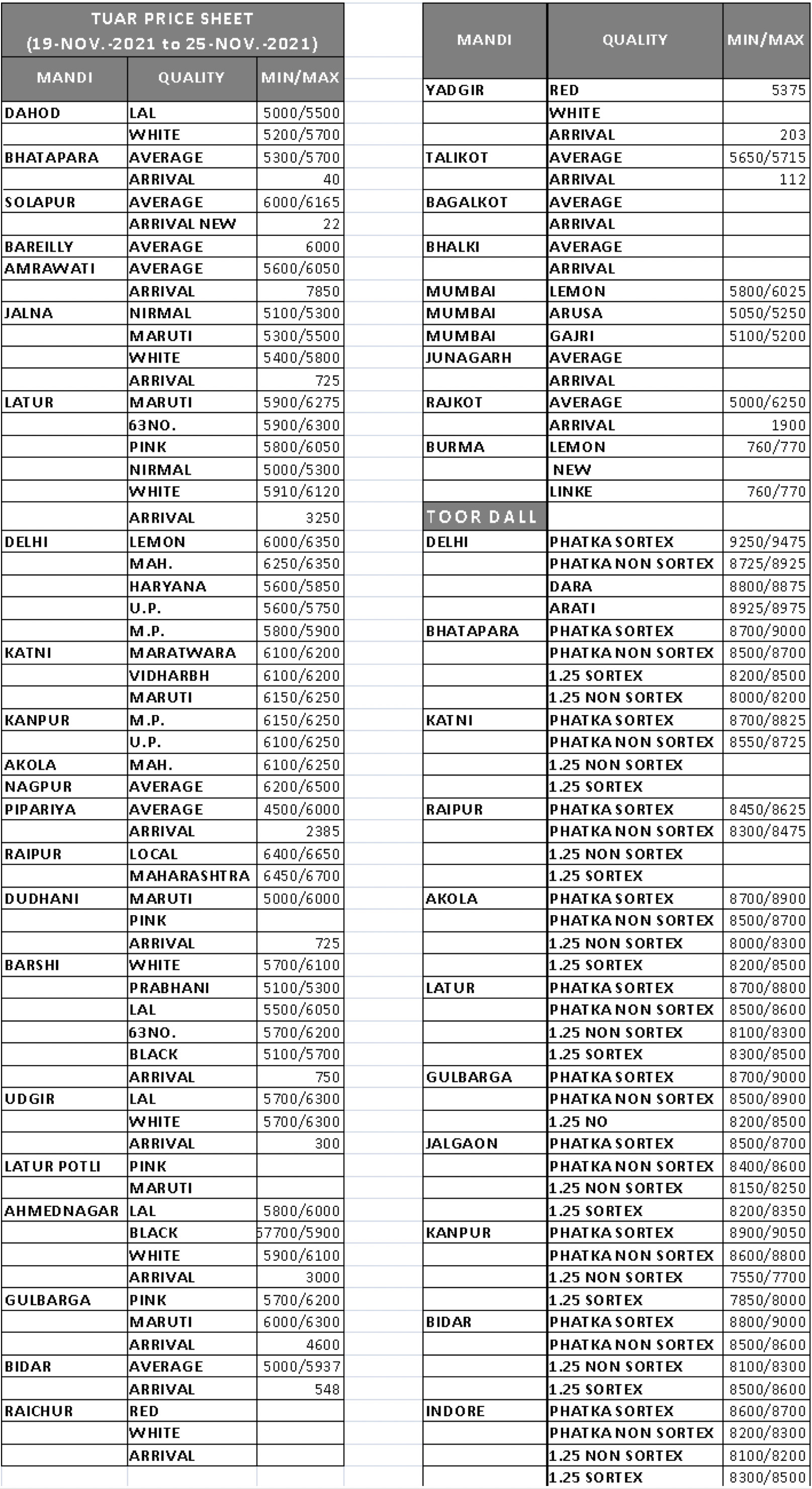
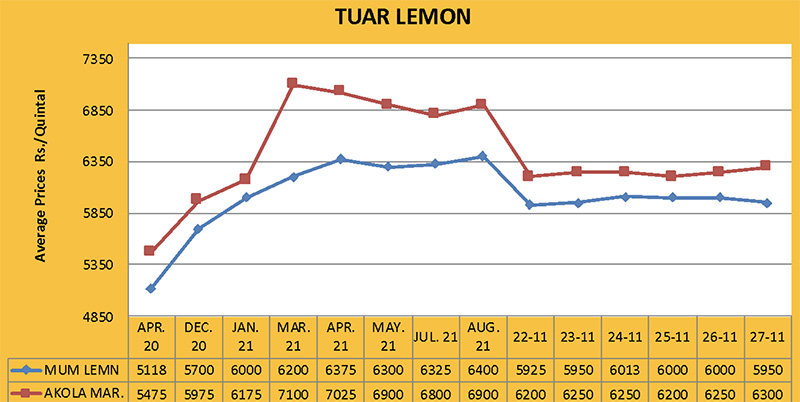
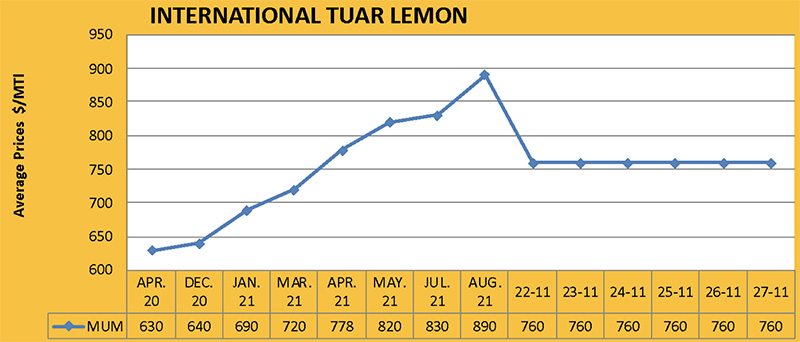
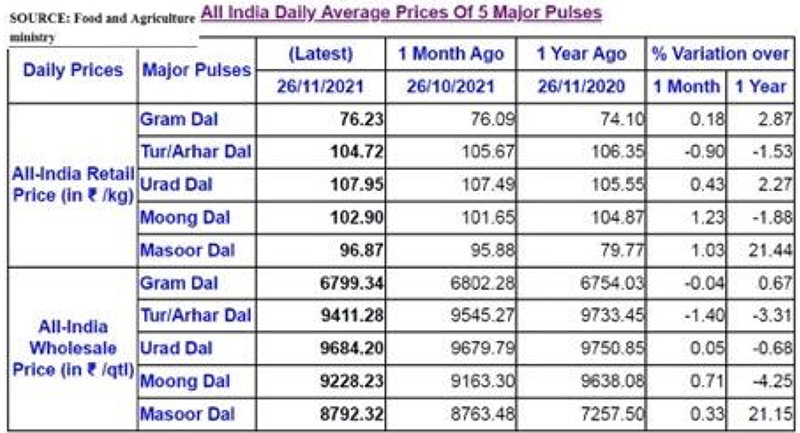
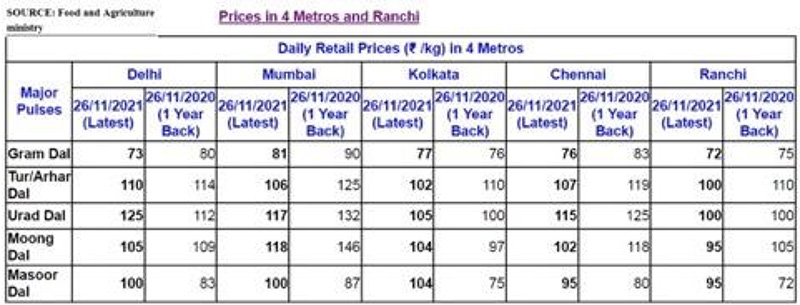
(November 25, 2021)
Export performance of wheat and maize better - business sluggish in pulses
Mumbai. Due to high wheat prices in major exporting countries, many countries of South Asia and South-East Asia are showing good interest in importing wheat from India. The export offer prices of Indian wheat are running at a competitive level. New wheat harvesting has begun in Australia but initial indications suggest that quality is not good. Export tariffs in Russia are high and Ukraine and Romania have also started increasing their wheat prices in view of the rising wheat prices in the US, Canada and the European Union.
Like wheat, maize is being exported from India. Domestic demand is also good.
Business in pulses is sluggish, which is worrying producers, stockists and millers. The arrival of the new tuar crop is expected to increase in coming days, while gram, masoor and peas are in the process of arriving.
(November 25, 2021)
Decision to give rice and pulses to flood-affected families in Andhra Pradesh
Vijayawada. In Andhra Pradesh, the state government announced it would provide essential food items including rice, pulses, edible oils, potatoes and onions free of charge to people in the areas affected by heavy rains and floods, including Chittoor, Nellore, Cuddapah and Anantapur. Last week, the Rayalaseema division of Andhra Pradesh had received widespread heavy rainfall accompanied by strong winds, while the Meteorological Department has expressed the possibility of further rains in the state.
The government has ordered 25 kg rice, 1 kg tuar dal, 1 liter edible oil and 1 kg potato and onion to families in the flood-affected areas. Crops have been submerged in water due to flooding in the fields. Torrential rain accompanied by strong wind killed 25 people while 17 others are said to be missing.
The Andhra Pradesh government has urged the Center to provide necessary assistance. The Chief Minister of the state had recently conducted an aerial survey of the flood-affected areas which showed that the districts of Cuddapah, Chittoor, Anantapur and Nellore have all been badly affected and Tirupati city is flooded. Due to the spate of Swarnamukhi, Papagni and Penna rivers, the flood water also spread in the surrounding areas.
The threat from Andhra Pradesh is not over yet. There has also been heavy damage to agricultural crops, which is yet to be surveyed and assessed.
(November 25, 2021)
Despite clearing the way for the return of agricultural laws, farmers' agitation continues
New Delhi. The Prime Minister himself had recently announced the withdrawal of all three controversial agricultural reform laws and on November 24, the Central Cabinet Committee on Economic Affairs (CCEA) approved the proposal to withdraw the bill. These bills were taken back by parliament on the first day of the winter session. The main reason for farmers' protest and agitation was the withdrawal of agricultural laws. Despite the decision to withdraw the laws, the farmers’ agitation continues because some of their other demands have not been discussed or decided yet. The most important demand is the statutory guarantee of the Minimum Support Price (MSP). Many statements are coming in both favor and opposition but the opposing statements do not seem to be very effective or logical. The central government announced a minimum support price for 23 crops, including both Kharif and Rabi seasons, but at this price the purchase is mainly done for paddy and wheat. Apart from this, pulses and oilseeds are also procured in limited quantities. There is no or negligible purchase of coarse cereals. The fixation of the minimum support price has become a heavy issue and the government’s food subsidy bill crossed Rs 1 lakh crore. Some economists believe that the production of food grains in India is more than 27-280 million tons and it will not be practical to purchase the entirety at the MSP. The government does not even have adequate storage facilities at present. However, the logic of farmer leaders is different, who say that the guarantee of the MSP does not mean that government agencies should buy all the produce but that if a private trader also wants to buy it, he must provide at least the minimum support price to the farmers. The Central Government has already expressed its resolve to double the income of farmers by the year 2022 and it has made commendable efforts in this direction but the target seems far away. The issue of guaranteeing the MSP is also linked to the provisions of the World Trade Organization, so the government is avoiding giving it legal recognition. He clearly says that the MSP will continue even further and farmers will continue to get a better price for their produce. This is a very complicated matter snf both sides will have to exercise a lot of restraint.
(November 26, 2021)
Sowing of Rabi crops completed in more than 79 lakh hectares in Rajasthan
Jaipur. In Rajasthan, an important agricultural producing state located in the western part of the country, the cultivation of Rabi crops had been completed in an area of 79.09 lakh hectares as of November 25 with a target of 100.80 lakh hectares. This is much more than the sown area of 66.38 lakh hectares in the corresponding period of last year. Last year, 98.80 lakh hectares of crops were sown in the entire Rabi season, while the five-year average figure of production area has been estimated at 96.92 lakh hectares.
According to the new weekly report of the State Agriculture Department, the area under wheat production in Rajasthan has increased from 13.64 lakh hectares to 16.19 lakh hectares and the barley area improved from 1.83 lakh hectares to 2.17 lakh hectares during the current Rabi season as compared to last year. As a result, the total area under cereal crops jumped from 15.47 lakh hectares to 18.36 lakh hectares. The area of pulses has improved from 17.77 lakh hectares to 17.81 lakh hectares. Under this, the sown area of gram increased from 17.54 lakh hectares to 17.66 lakh hectares, but the area of other pulses decreased from 23 thousand hectares to 15 thousand hectares. Despite this, the total production area of food grains including wheat, barley and pulses, has increased from 33.24 lakh hectares last year to over 36.17 lakh hectares this year.
On the other hand, there is a tremendous increase in the production area of oilseed crops, especially mustard seed. The sown area of mustard-rapeseed in Rajasthan has jumped from 22.89 lakh hectares last year to 32.48 lakh hectares this year, 16% more than the target of 28 lakh hectares. Similarly, the area of Taramira increased from 53 thousand hectares to 1.27 lakh hectares. The area of linseed, however, fell from 6 thousand hectares to 4 thousand hectares. The total area under oilseeds crops has increased from 23.48 lakh hectares last year to 33.79 lakh hectares this year. Rajasthan is the most important producer of mustard and barley, while in the production of gram, it is second only to Madhya Pradesh.
Government allows import of 16 lakh tonnes of urea
New Delhi. The Union Ministry of Fertilizers has accepted a proposal to import about 1.6 million tonnes of urea, worth $1.50 billion (about Rs 11,500 crore), which will be imported by Indian Potash Limited at the government level. This will help in increasing the availability of this important chemical fertilizer in the domestic division. Out of the total potential quantity of 16 lakh tons, about one million tons of urea will be imported at the ports located on the west coast of the country and the remaining 6 lakh tons at the ports on the east coast. About 15 companies have entered into contracts for the supply of urea after getting government approval. A contract for the import of 9 lakh tons of urea has been done at $ 981.64 per ton and 6 lakh tons at the price level of $ 998.50 per ton. Apart from this, the contract price for import of a little less than 1 ton of urea was made at $ 960 per ton. All these contract values also include the shipping charges for the goods reaching the Indian ports. Indian Potash Ltd. and National Fertilizer Ltd. were notified as authorized agencies for the import of urea by the government on November 3. Since the Government bears the entire subsidy while fixing the MRP of urea, imports are ensured through authorized channels to keep the prices stable in the domestic market. About 240-250 lakh tons of urea is produced in India and about 90-100 lakh tons is imported annually. Rabi crops are being sown vigorously so the government is relying on imports to meet the shortage of urea, and more will be imported into India from Russia and Egypt.


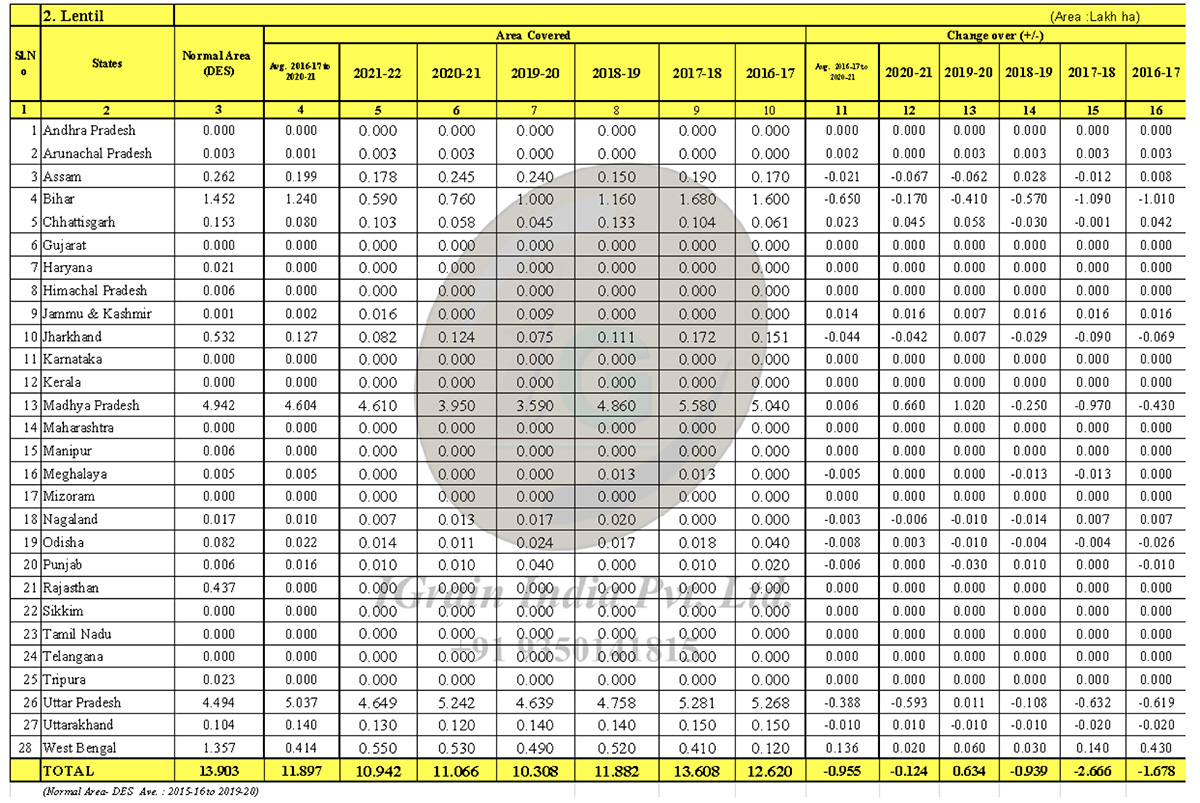
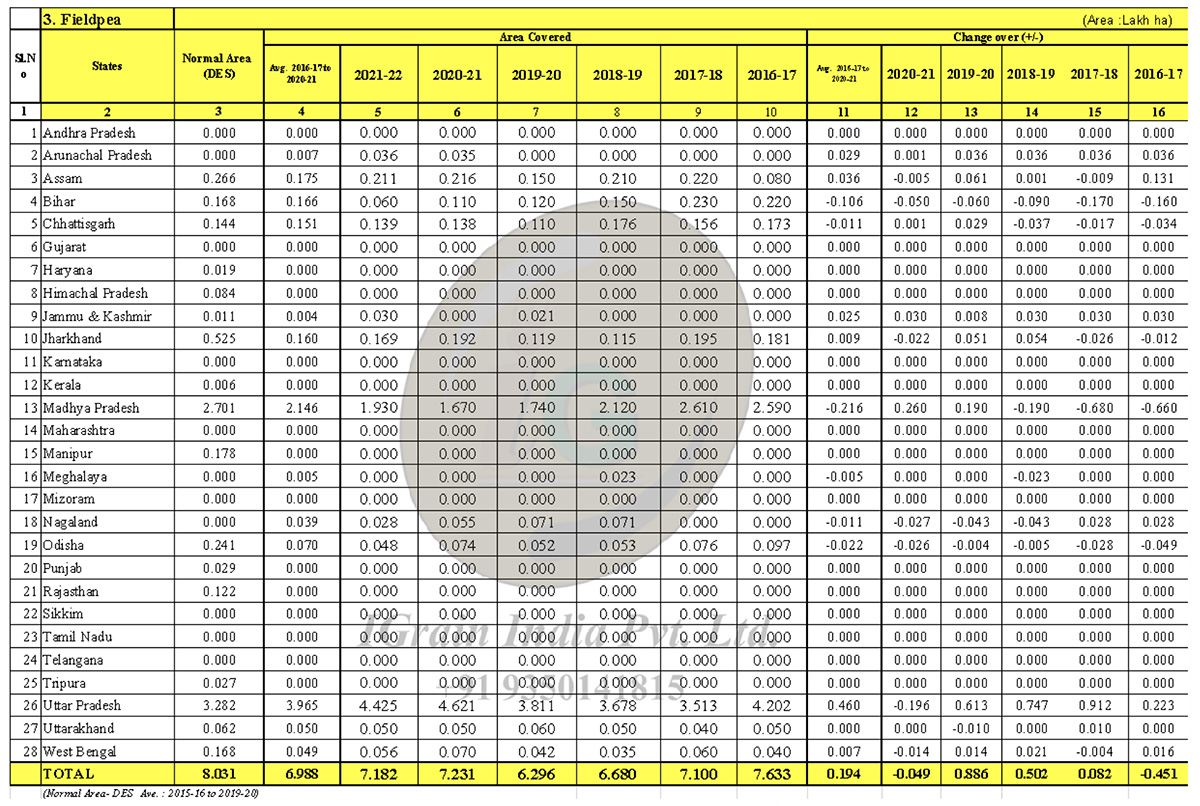
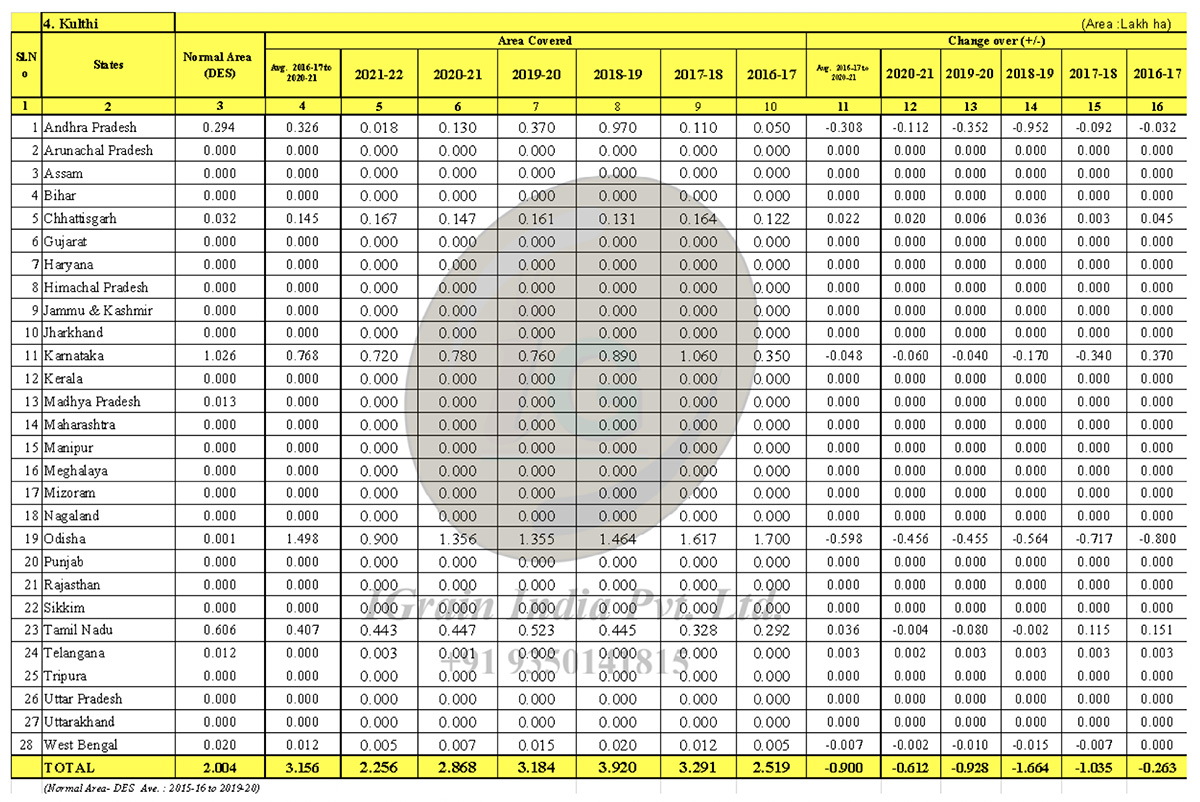
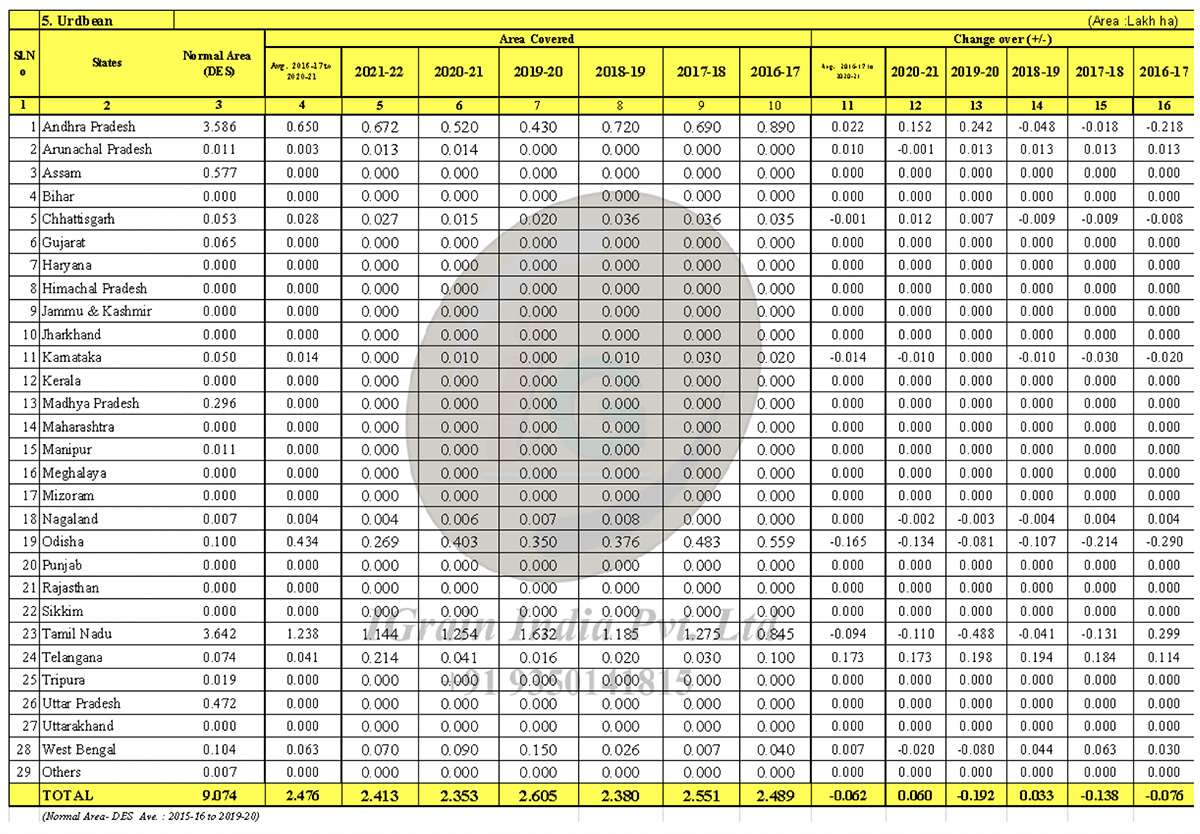

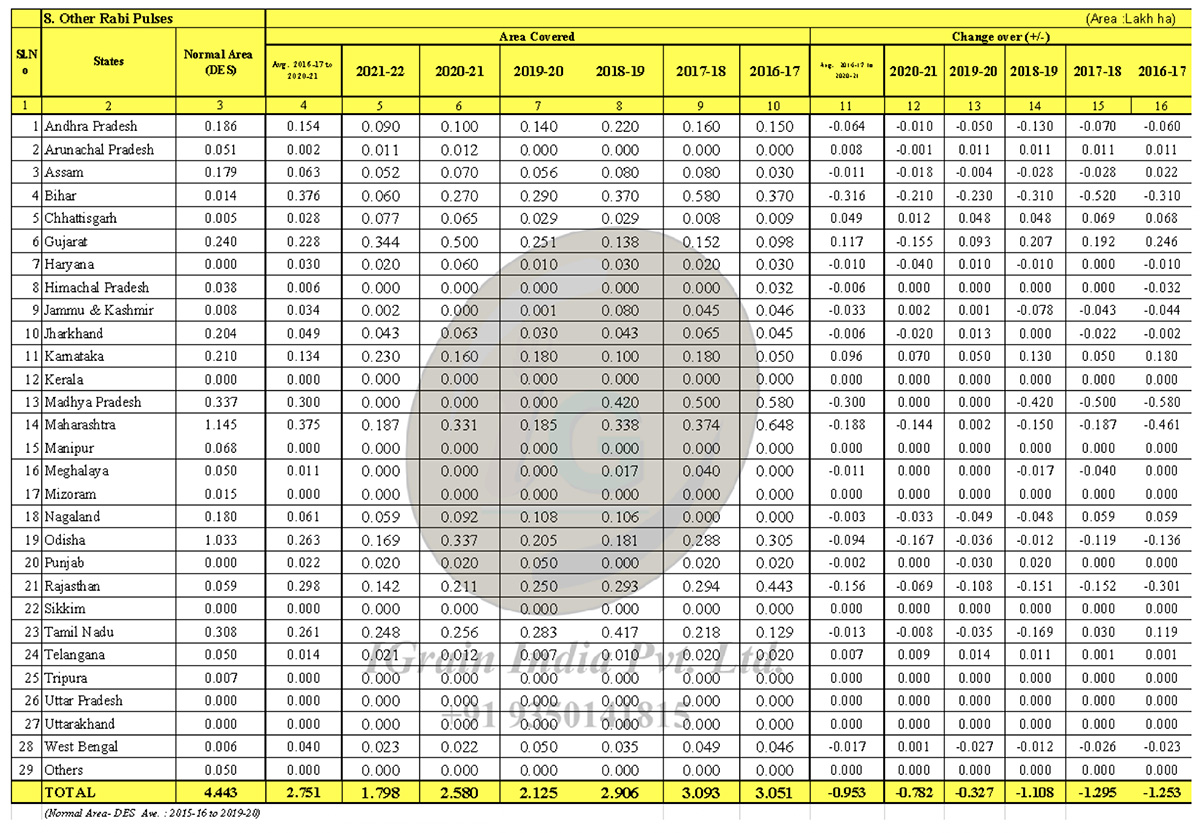
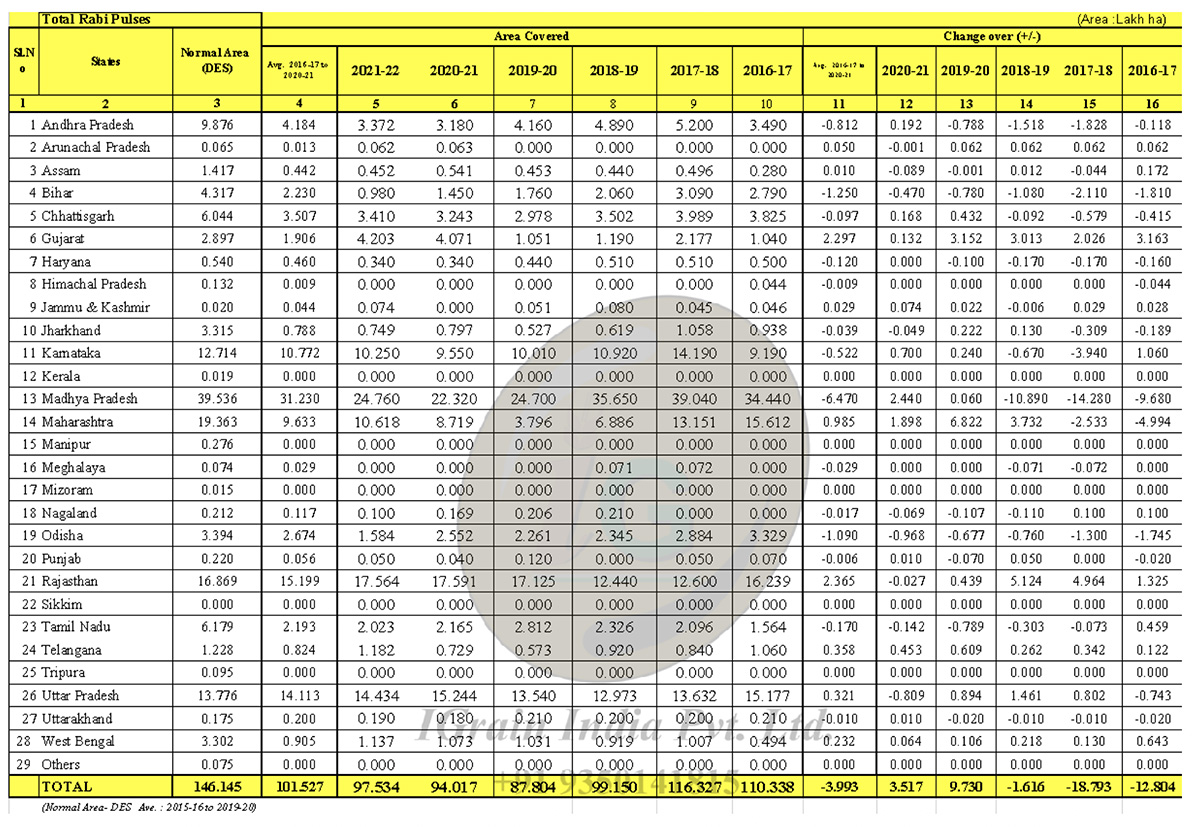
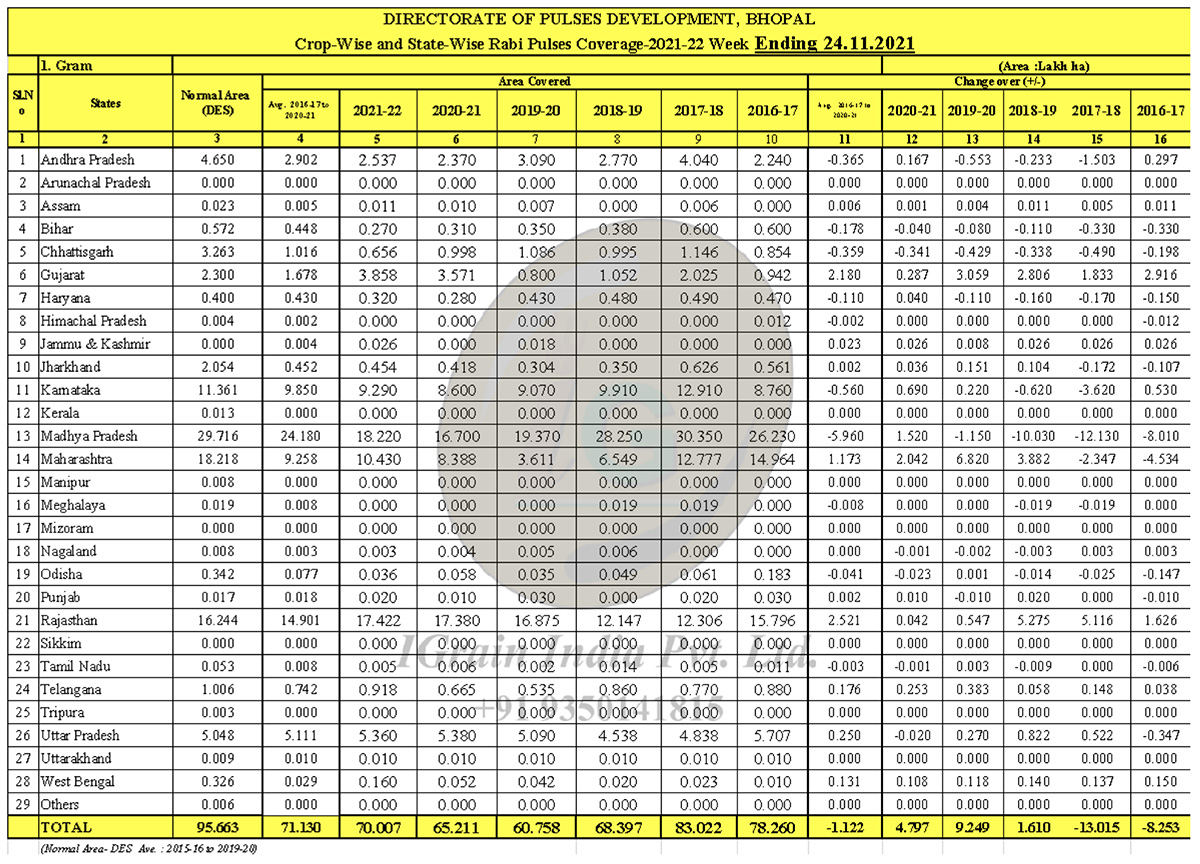
Abbreviations
Tuar/ Arhar: Pigeon Peas PP
Mung: Green Mung
Urad: Black Matpe
Chana: Gram, Desi Chickpea
Matar: Pea
Masur: Lentil
Besan: Gram Flour
Mandi: Market yard
Bhav: Prices
Dal/Daal: Processed Pulses (Directly for human consumption)
Rs: Indian Rupees (1$=Rs 74.92)
Rahul Chauhan
Director, IGrain India
igrainind@gmail.com
+91 9350141815
Twitter igrain_india

IGrain / Rahul Chauhan / India / Pigeon Pea / Karnataka / Maharashtra / Mumbai / Burma / Delhi / Chick Peas / Desi Chick Peas / Black Matpe / Mung Bean / Red Kidney Bean / Cowpea / Lentil / Pigeon Pea
Disclaimer: The opinions or views expressed in this publication are those of the authors or quoted persons. They do not purport to reflect the opinions or views of the Global Pulse Confederation or its members.